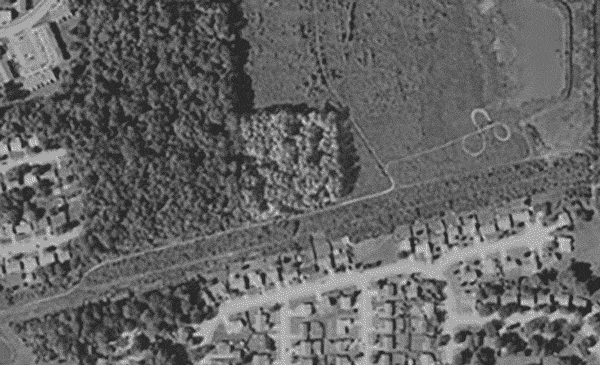
I watched a farm disappear before my eyes.
In a search to find answers to the hauntings I’d experienced on the Eastside of Indianapolis, I had taken to researching the history of the land just to the north of my home.
To that end, I had been comparing a series of aerial photographs from 1942 to present, when it hit me:
“That farm just disappeared!”
In a 1942 photo there were farm buildings, now there’s nothing but trees. The animated GIF above illustrates the changes to the terrain. Note the area in the center.
All at once I had a lot of questions.
- What happened to the farm?
- Who owns the property now?
- Why would a piece of land be taken over by a forest?
- Were there any remaining remnants of the farm?
Answering those questions led me on a fascinating journey to unravel the mystery.
The History of Hartman Farm
Christian Hartman was born in Germany in 1826. Like many Germans, he immigrated to America and purchased farmland on the Eastside of Marion County sometime in the mid to late 19th century. German Church Road owes its name to a popular church where the German immigrant population worshipped.
Christian and his wife raised his two sons there, and eventually Anthony (his eldest son) took over the farm. Anthony greatly expanded the farm until it stretched between the borders of German Church and Mitthoefer roads.
The 1900 census shows Anthony and his wife Sophie still living on the property along with 74 year-old Christian.
The census also tells of the hardships these immigrants endured. In one column of the census is the number of children each woman bore. In another column was the number still living.
In just a few square miles, a majority of the families had suffered the loss of at least one child. The columns with families who lost children read: 4 and 3, 3 and 2, 5 and 3, 3 and 2, 7 and 5, 2 and 1, 9 and 7. One unfortunate family lost 2 of their 5 children in just 5 years of marriage.
I wondered if this land was cursed even then or whether this was indicative of the typical child mortality rate of that era?
Anthony (34 years old) and Sophie (30 years old) had been married seven years and were still childless when the 1900 census was taken.
Headwaters and the Great Spirit
When the Hartmans worked the land, I can’t help but wonder if there were irrigation issues. Hartman farm sits at the headwaters of Grassy Creek just north of the railroad tracks that bordered the farm.
There is a small pond on the property today.
In researching Indian beliefs, I came across an interesting story.
The Native Americans believed the headwaters of a stream to be sacred. Wild game in these areas was always plentiful, and hunting was always easy, but the Indians also warned others not to over-hunt the headwaters.
A great spirit was said to have protected the animal population there. If a hunter became too greedy, he would feel the wrath of the great spirit.
Would clearing the land at the headwaters violate a Native American spiritual practice?
Grassy Creek lies very near my old haunted house. Was the spirit I encountered in my house related to Grassy Creek?
The Hartmans’ Passing
Anthony Hartman passed away in 1935 and was laid to rest in the cemetery just north of the aforementioned German Church. Sophie lived on until 1953 and was buried beside him.
In my research I was never able to determine whether they died childless.
A local farmer recalled that one of the Mitthoefers owned the land after the Hartmans. Was this transfer related to Anthony’s passing?
I regret I was never able to speak with Fred Mitthoefer, a gentleman whose mail was often confused with mine due to the fact that we had the same number in our street address.
The Passing of the Land
I still couldn’t answer the question of what happened to the property. It is currently owned by the Indianapolis Parks Department.
During a title search I saw the land had changed hands several times, but did not mention the Hartmans or Mithoeffers.
Google maps identifies the land as “Grassy Creek Park,” yet there are no roads leading onto the property.
Still, I felt assured that if I were to explore the property on foot, I wouldn’t be trespassing on private property.
It seemed inevitable that I would, indeed, need to explore the land to look for clues to the farm’s disappearance.
In part two I will reveal what I found.
